保護膜付き金ミラー

- Average Reflectance >96% from 800 nm to 20 µm
- Round and Square Mirrors Available
- Packages of 10 Rounds at a Discounted Price
PF20-03-M01
Ø2"
PF05-03-M01
Ø1/2"
PF10-03-M01
Ø1"
PF07-03-M01
Ø19 mm
PFSQ05-03-M01
1/2" x 1/2"
PFSQ10-03-M01
1" x 1"
PFSQ20-03-M01
2" x 2"
PF03-03-M01
Ø7 mm

Please Wait
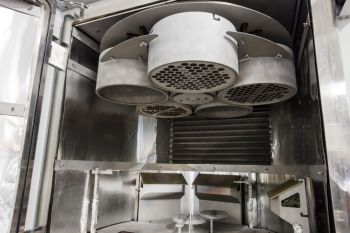
Click to Enlarge
電子ビーム蒸着コーティングチャンバの最上部の円形基板ホルダの金属ミラーブランク
| Other Protected Gold Mirrors |
|---|
| Right-Angle Mirrors Mounted Turning Mirror Economy Mirrors Concave Mirrors Elliptical Mirrors D-Shaped Mirrors |
特長
- 表面平面度: λ/10 (50.8 mm角ミラーではλ/8)
- 円形ミラーは Ø7 mm、Ø12.7 mm(Ø1/2インチ)、Ø19 mm、Ø25.4 mm(Ø1インチ)、Ø50.8 mm(Ø2インチ)の5種類をご用意
- 正方形ミラーは12.7 mm角、25.4 mm角、50.8 mm角の3種類をご用意
- Ravg>96% @800 nm~20 μm
当社では、様々なサイズの保護膜付き金コーティングミラー(円形および正方形)を提供しています。保護膜付き金は、全赤外域に渡って最も効率性の良い反射 コーティングです。金コーティングの上には損傷を防ぎクリーニングが容易な独自の保護膜が付いています。当社の金ミラーは800 nm~20 μmで平均反射率>96%です。「グラフ」タブ内の反射率曲線でもご覧いただけるように、他の金属コーティング付きのミラーと同様にこれらのミラーは入射角の変動には比較的依存しません。
Ø19 mmミラーは、特にレーザーシステムや他のOEM用にご用意しているPolaris固定式光学マウント用に設計されています。この直径サイズによって、マウントはØ25.4 mm(Ø1インチ)の設置面積を維持しながらØ12.7 mm(Ø1/2インチ)光学素子よりも大きな開口を得ることができます。また、Ø7 mm のミラーは当社ミニシリーズのキネマティックミラーマウントMK7/Mおよび固定式光学マウントLMR7/Mをお使いいただけます。
Ø12.7 mm(Ø1/2インチ)、Ø25.4 mm(Ø1インチ)およびØ50.8 mm(Ø2インチ)の円形ミラーは、10枚入りパックをご購入いただくと通常よりもお得になっています。
非常に低い熱膨張係数が必要な用途には、保護膜付きZerodur金ミラーをご用意しています。
カスタム仕様の金属製ミラー
当社の金属製ミラーはアメリカ、ニュージャージー州ニュートンの製造施設で製造されています。当社の光学素子事業部は幅広い製造能力を有しており、OEM用途や少ロット単発でのご相談もお受けしております。サイズ、形状、基板、ならびにコーティングをカスタマイズした光学素子やガルバノスキャナなどの特注部品をご提供可能です。カスタム品の詳細については当社までお問い合わせください。
| Metal-Coated Plano Mirrors Selection Guide | ||||
|---|---|---|---|---|
Wavelength Range | Avg. Reflectance | Coating | Suffix | Coating Comparison |
| 250 nm - 450 nm | >90% | UV Enhanced Aluminum | -F01 | Raw Data |
| 450 nm - 20 μm | >90% for 450 nm - 2 µm >95% for 2 - 20 µm | Protected Aluminum | -G01 | |
| 750 nm - 1 µm | Rs > 99.0% RP > 98.5% | Ultrafast-Enhanced Silver | -AG | Raw Data |
| 450 nm - 20 μm | >97.5% for 450 nm - 2 µm >96% for 2 - 20 µm | Protected Silver | -P01 | |
| >97% for 450 nm - 2 µm >95% for 2 - 20 µm | Protected Silvera | -P02 | ||
| 800 nm - 20 μm | >96% | Protected Gold | -M01 | Raw Data |
| 2 µm - 20 µm | >98% | MIR Enhanced Gold | -M02 | |
| 800 nm - 20 μm | >97% | Unprotected Gold | -M03 | |
| 10.6 µm Laser Line | >99% | Unprotected Gold | -L01 | |
| Metal-Coated Zerodur® Mirrors | ||||
| Economy Front Surface Mirrors with Protected Metallic Coatings | ||||
グラフの青い網掛け部分は、このミラーをご使用になる際に推奨する波長範囲を示しています。 この帯域の外側(特に反射率のグラフに変動や傾斜がみられる範囲)の反射率は、ロット毎にバラつきがある可能性があります。
| Damage Threshold Specifications | |
|---|---|
| Coating Designation (Item # Suffix) | Damage Threshold |
| -M01 (Pulsed) | 2 J/cm2 (1.064 µm, 10 ns, 10 Hz, Ø1.000 mm) |
| -M01 (CW)a | 500 W/cm (1.070 µm, Ø0.089 mm) 750 W/cm (10.6 µm, Ø0.339 mm) |
当社の保護膜付き金ミラーの損傷閾値データ
右の仕様は当社の保護膜付き金ミラーの測定値です。損傷閾値の仕様はミラーのサイズや焦点距離にかかわらずすべての保護膜付き金ミラーで同じです。
レーザによる損傷閾値について
このチュートリアルでは、レーザ損傷閾値がどのように測定され、使用する用途に適切な光学素子の決定にその値をどのようにご利用いただけるかを総括しています。お客様のアプリケーションにおいて、光学素子を選択する際、光学素子のレーザによる損傷閾値(Laser Induced Damage Threshold :LIDT)を知ることが重要です。光学素子のLIDTはお客様が使用するレーザの種類に大きく依存します。連続(CW)レーザは、通常、吸収(コーティングまたは基板における)によって発生する熱によって損傷を引き起こします。一方、パルスレーザは熱的損傷が起こる前に、光学素子の格子構造から電子が引き剥がされることによって損傷を受けます。ここで示すガイドラインは、室温で新品の光学素子を前提としています(つまり、スクラッチ&ディグ仕様内、表面の汚染がないなど)。光学素子の表面に塵などの粒子が付くと、低い閾値で損傷を受ける可能性があります。そのため、光学素子の表面をきれいで埃のない状態に保つことをお勧めします。光学素子のクリーニングについては「光学素子クリーニングチュートリアル」をご参照ください。
テスト方法
当社のLIDTテストは、ISO/DIS 11254およびISO 21254に準拠しています。
初めに、低パワー/エネルギのビームを光学素子に入射します。その光学素子の10ヶ所に1回ずつ、設定した時間(CW)またはパルス数(決められたprf)、レーザを照射します。レーザを照射した後、倍率約100倍の顕微鏡を用いた検査で確認し、すべての確認できる損傷を調べます。特定のパワー/エネルギで損傷のあった場所の数を記録します。次に、そのパワー/エネルギを増やすか減らすかして、光学素子にさらに10ヶ所レーザを照射します。このプロセスを損傷が観測されるまで繰返します。損傷閾値は、光学素子が損傷に耐える、損傷が起こらない最大のパワー/エネルギになります。1つのミラーBB1-E02の試験結果は以下のようなヒストグラムになります。
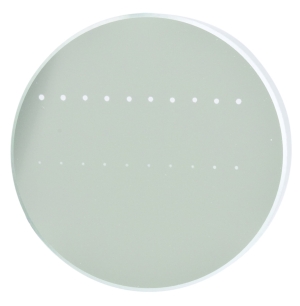
上の写真はアルミニウムをコーティングしたミラーでLIDTテストを終えたものです。このテストは、損傷を受ける前のレーザのエネルギは0.43 J/cm2 (1064 nm、10 ns pulse、 10 Hz、Ø1.000 mm)でした。
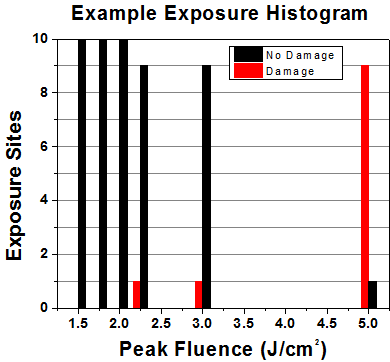
| Example Test Data | |||
|---|---|---|---|
| Fluence | # of Tested Locations | Locations with Damage | Locations Without Damage |
| 1.50 J/cm2 | 10 | 0 | 10 |
| 1.75 J/cm2 | 10 | 0 | 10 |
| 2.00 J/cm2 | 10 | 0 | 10 |
| 2.25 J/cm2 | 10 | 1 | 9 |
| 3.00 J/cm2 | 10 | 1 | 9 |
| 5.00 J/cm2 | 10 | 9 | 1 |
試験結果によれば、ミラーの損傷閾値は 2.00 J/cm2 (532 nm、10 ns pulse、10 Hz、 Ø0.803 mm)でした。尚、汚れや汚染によって光学素子の損傷閾値は大幅に低減されるため、こちらの試験はクリーンな光学素子で行っています。また、特定のロットのコーティングに対してのみ試験を行った結果ではありますが、当社の損傷閾値の仕様は様々な因子を考慮して、実測した値よりも低めに設定されており、全てのコーティングロットに対して適用されています。
CWレーザと長パルスレーザ
光学素子がCWレーザによって損傷を受けるのは、通常バルク材料がレーザのエネルギを吸収することによって引き起こされる溶解、あるいはAR(反射防止)コーティングのダメージによるものです[1]。1 µsを超える長いパルスレーザについてLIDTを論じる時は、CWレーザと同様に扱うことができます。
パルス長が1 nsと1 µs の間のときは、損傷は吸収、もしくは絶縁破壊のどちらかで発生していると考えることができます(CWとパルスのLIDT両方を調べなければなりません)。吸収は光学素子の固有特性によるものか、表面の不均一性によるものかのどちらかによって起こります。従って、LIDTは製造元の仕様以上の表面の質を有する光学素子にのみ有効です。多くの光学素子は、ハイパワーCWレーザで扱うことができる一方、アクロマティック複レンズのような接合レンズやNDフィルタのような高吸収光学素子は低いCWレーザ損傷閾値になる傾向にあります。このような低い損傷閾値は接着剤や金属コーティングにおける吸収や散乱によるものです。
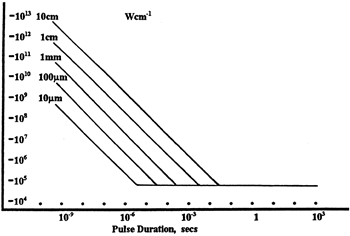
線形パワー密度におけるLIDTに対するパルス長とスポットサイズ。長パルス~CWでは線形パワー密度はスポットサイズにかかわらず一定です。 このグラフの出典は[1]です。
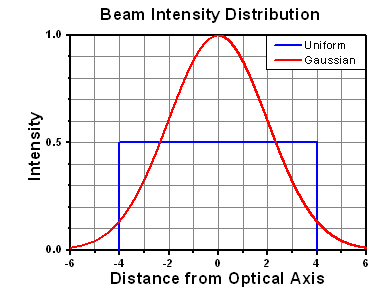
繰返し周波数(prf)の高いパルスレーザは、光学素子に熱的損傷も引き起こします。この場合は吸収や熱拡散率のような因子が深く関係しており、残念ながらprfの高いレーザが熱的影響によって光学素子に損傷を引き起こす場合の信頼性のあるLIDTを求める方法は確立されておりません。prfの大きいビームでは、平均出力およびピークパワーの両方を等しいCW出力と比較する必要があります。また、非常に透過率の高い材料では、prfが上昇してもLIDTの減少は皆無かそれに近くなります。
ある光学素子の固有のCWレーザの損傷閾値を使う場合には、以下のことを知る必要があります。
- レーザの波長
- ビーム径(1/e2)
- ビームのおおよその強度プロファイル(ガウシアン型など)
- レーザのパワー密度(トータルパワーをビームの強度が1/e2の範囲の面積で割ったもの)
ビームのパワー密度はW/cmの単位で計算します。この条件下では、出力密度はスポットサイズとは無関係になります。つまり、スポットサイズの変化に合わせてLIDTを計算し直す必要がありません(右グラフ参照)。平均線形パワー密度は、下の計算式で算出できます。

ここでは、ビーム強度プロファイルは一定であると仮定しています。次に、ビームがホットスポット、または他の不均一な強度プロファイルの場合を考慮して、おおよその最大パワー密度を計算する必要があります。ご参考までに、ガウシアンビームのときはビームの強度が1/e2の2倍のパワー密度を有します(右下図参照)。
次に、光学素子のLIDTの仕様の最大パワー密度を比較しましょう。損傷閾値の測定波長が光学素子に使用する波長と異なっている場合には、その損傷閾値は適宜補正が必要です。おおよその目安として参考にできるのは、損傷閾値は波長に対して比例関係であるということです。短い波長で使う場合、損傷閾値は低下します(つまり、1310 nmで10 W/cmのLIDTならば、655 nmでは5 W/cmと見積もります)。

この目安は一般的な傾向ですが、LIDTと波長の関係を定量的に示すものではありません。例えば、CW用途では、損傷はコーティングや基板の吸収によってより大きく変化し、必ずしも一般的な傾向通りとはなりません。上記の傾向はLIDT値の目安として参考にしていただけますが、LIDTの仕様波長と異なる場合には当社までお問い合わせください。パワー密度が光学素子の補正済みLIDTよりも小さい場合、この光学素子は目的の用途にご使用いただけます。
当社のウェブ上の損傷閾値の仕様と我々が行った実際の実験の値の間にはある程度の差があります。これはロット間の違いによって発生する誤差を許容するためです。ご要求に応じて、当社は個別の情報やテスト結果の証明書を発行することもできます。損傷解析は、類似した光学素子を用いて行います(お客様の光学素子には損傷は与えません)。試験の費用や所要時間などの詳細は、当社までお問い合わせください。
パルスレーザ
先に述べたように、通常、パルスレーザはCWレーザとは異なるタイプの損傷を光学素子に引き起こします。パルスレーザは損傷を与えるほど光学素子を加熱しませんが、光学素子から電子をひきはがします。残念ながら、お客様のレーザに対して光学素子のLIDTの仕様を照らし合わせることは非常に困難です。パルスレーザのパルス幅に起因する光学素子の損傷には、複数の形態があります。以下の表中のハイライトされた列は当社の仕様のLIDT値が当てはまるパルス幅に対する概要です。
パルス幅が10-9 sより短いパルスについては、当社の仕様のLIDT値と比較することは困難です。この超短パルスでは、多光子アバランシェ電離などのさまざまなメカニクスが損傷機構の主流になります[2]。対照的に、パルス幅が10-7 sと10-4 sの間のパルスは絶縁破壊、または熱的影響により光学素子の損傷を引き起こすと考えられます。これは、光学素子がお客様の用途に適しているかどうかを決定するために、レーザービームに対してCWとパルス両方による損傷閾値を参照しなくてはならないということです。
| Pulse Duration | t < 10-9 s | 10-9 < t < 10-7 s | 10-7 < t < 10-4 s | t > 10-4 s |
|---|---|---|---|---|
| Damage Mechanism | Avalanche Ionization | Dielectric Breakdown | Dielectric Breakdown or Thermal | Thermal |
| Relevant Damage Specification | No Comparison (See Above) | Pulsed | Pulsed and CW | CW |
お客様のパルスレーザに対してLIDTを比較する際は、以下のことを確認いただくことが重要です。
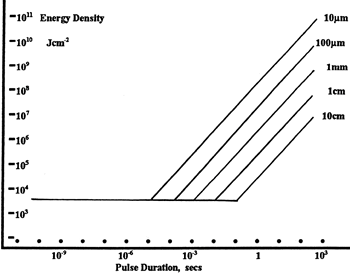
エネルギ密度におけるLIDTに対するパルス長&スポットサイズ。短パルスでは、エネルギ密度はスポットサイズにかかわらず一定です。このグラフの出典は[1]です。
- レーザの波長
- ビームのエネルギ密度(トータルエネルギをビームの強度が1/e2の範囲の面積で割ったもの)
- レーザのパルス幅
- パルスの繰返周波数(prf)
- 実際に使用するビーム径(1/e2 )
- ビームのおおよその強度プロファイル(ガウシアン型など)
ビームのエネルギ密度はJ/cm2の単位で計算します。右のグラフは、短パルス光源には、エネルギ密度が適した測定量であることを示しています。この条件下では、エネルギ密度はスポットサイズとは無関係になります。つまり、スポットサイズの変化に合わせてLIDTを計算し直す必要がありません。ここでは、ビーム強度プロファイルは一定であると仮定しています。ここで、ビームがホットスポット、または他の不均一な強度プロファイルの場合を考慮して、おおよその最大パワー密度を計算する必要があります。ご参考までに、ガウシアンビームのときは一般にビームの強度が1/e2のときの2倍のパワー密度を有します。
次に、光学素子のLIDTの仕様と最大エネルギ密度を比較しましょう。損傷閾値の測定波長が光学素子に使用する波長と異なっている場合には、その損傷閾値は適宜補正が必要です[3]。経験則から、損傷閾値は波長に対して以下のような平方根の関係であるということです。短い波長で使う場合、損傷閾値は低下します(例えば、1064 nmで 1 J/cm2のLIDTならば、532 nmでは0.7 J/cm2と計算されます)。

波長を補正したエネルギ密度を得ました。これを以下のステップで使用します。
ビーム径は損傷閾値を比較する時にも重要です。LIDTがJ/cm2の単位で表される場合、スポットサイズとは無関係になりますが、ビームサイズが大きい場合、LIDTの不一致を引き起こす原因でもある不具合が、より明らかになる傾向があります[4]。ここで示されているデータでは、LIDTの測定には<1 mmのビーム径が用いられています。ビーム径が5 mmよりも大きい場合、前述のようにビームのサイズが大きいほど不具合の影響が大きくなるため、LIDT (J/cm2)はビーム径とは無関係にはなりません。
次に、パルス幅について補正します。パルス幅が長くなるほど、より大きなエネルギに光学素子は耐えることができます。パルス幅が1~100 nsの場合の近似式は以下のようになります。

お客様のレーザのパルス幅をもとに、光学素子の補正されたLIDTを計算するのにこの計算式を使います。お客様の最大エネルギ密度が、この補正したエネルギ密度よりも小さい場合、その光学素子はお客様の用途でご使用いただけます。ご注意いただきたい点は、10-9 s と10-7 sの間のパルスにのみこの計算が使えることです。パルス幅が10-7 sと10-4 sの間の場合には、CWのLIDTも調べなければなりません。
当社のウェブ上の損傷閾値の仕様と我々が行った実際の実験の値の間にはある程度の差があります。これはロット間の違いによって発生する誤差を許容するためです。ご要求に応じて、当社では個別のテスト情報やテスト結果の証明書を発行することも可能です。詳細は、当社までお問い合わせください。
[1] R. M. Wood, Optics and Laser Tech. 29, 517 (1997).
[2] Roger M. Wood, Laser-Induced Damage of Optical Materials (Institute of Physics Publishing, Philadelphia, PA, 2003).
[3] C. W. Carr et al., Phys. Rev. Lett. 91, 127402 (2003).
[4] N. Bloembergen, Appl. Opt. 12, 661 (1973).
レーザーシステムが光学素子に損傷を引き起こすかどうか判断するプロセスを説明するために、レーザによって引き起こされる損傷閾値(LIDT)の計算例をいくつかご紹介します。同様の計算を実行したい場合には、右のボタンをクリックしてください。計算ができるスプレッドシートをダウンロードいただけます。ご使用の際には光学素子のLIDTの値と、レーザーシステムの関連パラメータを緑の枠内に入力してください。スプレッドシートでCWならびにパルスの線形パワー密度、ならびにパルスのエネルギ密度を計算できます。これらの値はスケーリング則に基づいて、光学素子のLIDTの調整スケール値を計算するのに用いられます。計算式はガウシアンビームのプロファイルを想定しているため、ほかのビーム形状(均一ビームなど)には補正係数を導入する必要があります。 LIDTのスケーリング則は経験則に基づいていますので、確度は保証されません。なお、光学素子やコーティングに吸収があると、スペクトル領域によってLIDTが著しく低くなる場合があります。LIDTはパルス幅が1ナノ秒(ns)未満の超短パルスには有効ではありません。

ガウシアンビームの最大強度は均一ビームの約2倍です。
CWレーザの例
波長1319 nm、ビーム径(1/e2)10 mm、パワー0.5 Wのガウシアンビームを生成するCWレーザーシステム想定します。このビームの平均線形パワー密度は、全パワーをビーム径で単純に割ると0.5 W/cmとなります。

しかし、ガウシアンビームの最大パワー密度は均一ビームの約2倍です(右のグラフ参照)。従って、システムのより正確な最大線形パワー密度は1 W/cmとなります。
アクロマティック複レンズAC127-030-CのCW LIDTは、1550 nmでテストされて350 W/cmとされています。CWの損傷閾値は通常レーザ光源の波長に直接スケーリングするため、LIDTの調整値は以下のように求められます。

LIDTの調整値は350 W/cm x (1319 nm / 1550 nm) = 298 W/cmと得られ、計算したレーザーシステムのパワー密度よりも大幅に高いため、この複レンズをこの用途に使用しても安全です。
ナノ秒パルスレーザの例:パルス幅が異なる場合のスケーリング
出力が繰返し周波数10 Hz、波長355 nm、エネルギ1 J、パルス幅2 ns、ビーム径(1/e2)1.9 cmのガウシアンビームであるNd:YAGパルスレーザーシステムを想定します。各パルスの平均エネルギ密度は、パルスエネルギをビームの断面積で割って求めます。

上で説明したように、ガウシアンビームの最大エネルギ密度は平均エネルギ密度の約2倍です。よって、このビームの最大エネルギ密度は約0.7 J/cm2です。
このビームのエネルギ密度を、広帯域誘電体ミラーBB1-E01のLIDT 1 J/cm2、そしてNd:YAGレーザーラインミラーNB1-K08のLIDT 3.5 J/cm2と比較します。LIDTの値は両方とも、波長355 nm、パルス幅10 ns、繰返し周波数10 Hzのレーザで計測しました。従って、より短いパルス幅に対する調整を行う必要があります。 1つ前のタブで説明したようにナノ秒パルスシステムのLIDTは、パルス幅の平方根にスケーリングします:

この調整係数により広帯域誘電体ミラーBB1-E01のLIDTは0.45 J/cm2に、Nd:YAGレーザーラインミラーのLIDTは1.6 J/cm2になり、これらをビームの最大エネルギ密度0.7 J/cm2と比較します。広帯域ミラーはレーザによって損傷を受ける可能性があり、より特化されたレーザーラインミラーがこのシステムには適していることが分かります。
ナノ秒パルスレーザの例:波長が異なる場合のスケーリング
波長1064 nm、繰返し周波数2.5 Hz、パルスエネルギ100 mJ、パルス幅10 ns、ビーム径(1/e2)16 mmのレーザ光を、NDフィルタで減衰させるようなパルスレーザーシステムを想定します。これらの数値からガウシアン出力における最大エネルギ密度は0.1 J/cm2になります。Ø25 mm、OD 1.0の反射型NDフィルタ NDUV10Aの損傷閾値は355 nm、10 nsのパルスにおいて0.05 J/cm2で、同様の吸収型フィルタ NE10Aの損傷閾値は532 nm、10 nsのパルスにおいて10 J/cm2です。1つ前のタブで説明したように光学素子のLIDTは、ナノ秒パルス領域では波長の平方根にスケーリングします。

スケーリングによりLIDTの調整値は反射型フィルタでは0.08 J/cm2、吸収型フィルタでは14 J/cm2となります。このケースでは吸収型フィルタが光学損傷を防ぐには適した選択肢となります。
マイクロ秒パルスレーザの例
パルス幅1 µs、パルスエネルギ150 µJ、繰返し周波数50 kHzで、結果的にデューティーサイクルが5%になるレーザーシステムについて考えてみます。このシステムはCWとパルスレーザの間の領域にあり、どちらのメカニズムでも光学素子に損傷を招く可能性があります。レーザーシステムの安全な動作のためにはCWとパルス両方のLIDTをレーザーシステムの特性と比較する必要があります。
この比較的長いパルス幅のレーザが、波長980 nm、ビーム径(1/e2)12.7 mmのガウシアンビームであった場合、線形パワー密度は5.9 W/cm、1パルスのエネルギ密度は1.2 x 10-4 J/cm2となります。これをポリマーゼロオーダ1/4波長板WPQ10E-980のLIDTと比較してみます。CW放射に対するLIDTは810 nmで5 W/cm、10 nsパルスのLIDTは810 nmで5 J/cm2です。前述同様、光学素子のCW LIDTはレーザ波長と線形にスケーリングするので、CWの調整値は980 nmで6 W/cmとなります。一方でパルスのLIDTはレーザ波長の平方根とパルス幅の平方根にスケーリングしますので、1 µsパルスの980 nmでの調整値は55 J/cm2です。光学素子のパルスのLIDTはパルスレーザのエネルギ密度よりはるかに大きいので、個々のパルスが波長板を損傷することはありません。しかしレーザの平均線形パワー密度が大きいため、高出力CWビームのように光学素子に熱的損傷を引き起こす可能性があります。
| Posted Comments: | |
Hong Qiu
(posted 2021-07-05 15:56:54.933) Hello, How thick the gold layer is? I saw two totally different answers, among which one is around 0.1 um and the other one is 1 um. I hope to use it to reflect terahertz waves. Does it work in the THz region? Regards. YLohia
(posted 2021-07-07 02:58:55.0) Hello, as an estimate, the gold coating layer is roughly 0.1 um thick. Gold coated mirrors do tend to be good THz reflectors, though we haven't performed extensive testing in this region: https://www.osapublishing.org/ao/abstract.cfm?URI=ao-50-19-3201 Jacques De Beer
(posted 2020-09-26 13:24:11.44) Good afternoon,
Is there an option for a custom size mirror that can be made? I require a mirror with a minimum size of 50 mm x 100 mm. 100 mm x 100 mm is also an option if a rectangle is not a shape that you work with. YLohia
(posted 2020-09-28 08:35:27.0) Hello, custom optics can be requested by clicking on the red "Request Quote" button above or by emailing Tech Support (techsupport@thorlabs.com). We will discuss the possibility of offering this customization via email. user
(posted 2020-03-22 15:11:22.49) Do you have protected or IR enhanced gold mirror in 25 mm x 36 mm x 1 mm rectangular dimension? YLohia
(posted 2020-03-23 10:41:09.0) Hello, thank you for contacting Thorlabs. Unfortunately, we currently do not offer 25 mm x 36 mm x 1 mm gold mirrors. We may, however, be able to offer this as a custom option. We will reach out to you directly to discuss this. Xiao Guo
(posted 2019-09-04 01:41:33.26) Dear Sir or Madam,
We buy a protected gold mirror from you and wondering the thickness of gold and the thickness of protection layer.
Is that available?
Thank you very much!
Peter YLohia
(posted 2019-09-04 12:01:27.0) Hello Peter, thank you for contacting Thorlabs. Unfortunately, we cannot share the layer thicknesses as this information is proprietary. lebouquj
(posted 2018-06-07 16:52:30.497) Hello, Do you think it could be possible to get a PF05-03-M01 with coating extending up to the chamfer (say at least 0.2mm) ? Thanks, Jean-Baptiste nbayconich
(posted 2018-06-12 10:38:38.0) Thank you for contacting Thorlabs. We can look into providing this as a custom order item. I will reach out to you directly with more information.
For any custom requests or special orders please contact techsupport@thorlabs.com directly. engel
(posted 2018-01-11 15:49:01.62) Dear Sir or Madam,
do you have any measurement for the protected gold mirror concerning reflectivity with a 0° angle of incident and are willing to share?
Is around 100nm Sio2 as a protection coating still in use?
Thanks in advance,
Philip nbayconich
(posted 2018-01-19 01:52:15.0) Thank you for contacting Thorlabs. The reflectance data at 12º vs 0º AOI will be similar due to the small angle approximation. Zero degrees AOI cannot be directly measured since there must be space between the source and detector. I will reach out to you directly with additional reflectivity data. The protective layer thickness is still on the order of 100nm however the exact coating thickness is proprietary information. jean-michel.melkonian
(posted 2017-02-16 11:03:23.01) Dear Thorlabs,
I'm afraid the reflectivity curve of the gold-protected mirror for the P polarization at 45° is totally, awfully wrong.
Indeed, at 8.1 µm, I have measured a ~50% reflectivity for the P polarization, while it is close to 100% for the S polarization.
The reason for this is a surface plasmon resonance taking place in the gold layer, a plasmon which is excited by the evanescent wave after total internal reflection of the light at the glass/gold interface.
According to theoretical calculations, this resonance is located at 8.05 µm in gold, assuming a 148-nm-thick SiO2 protective layer.
Obviously, this should not happen with an unprotected mirror gold (except at grazing incidence), nor for the S polarization, nor for a normal incidence.
I can send you curves if you like. tfrisch
(posted 2017-02-17 04:33:38.0) Hello, thank you for contacting Thorlabs. As the accepted industry standard for reflectance measurement uses broadband incoherent source, that is how our data was collected. As coherent sources in the mid-IR become more common and tunable, effects like the plasmon resonance you note may be more critical to our customers. Thank you for taking the time to discuss this with me. I have shared your concerns to our Laser Division which is committed to identifying, enabling, and accelerating MIR technologies. chen_zilong
(posted 2016-10-14 13:50:43.517) I would like to know the phase difference between s and p polarization for the PF10-03-M01 mirrors at 45 degree, and 0 degree angle of incidence at wavelengths of 780nm, 795nm and 810nm. Thank you! tfrisch
(posted 2016-10-25 09:19:34.0) Hello, thank you for contacting Thorlabs. The Gold coating M01 has a dielectric coating on top to protect it. While the gold itself should have little effect on the polarization, this dielectric coating will introduce dispersion between the polarization states. Unfortunately, this is not monitored from one coating run to another, and there will be significant variations. You may be interested in our unprotected gold coating M03. I have contacted you with a link including more details. rodrigo.cortinas
(posted 2016-08-24 05:46:16.38) Dear Team,
I am wondering if there is any "caveat" to the reflectivity of PF20-03-MO1 Gold protected mirror.
I am using a 1064nm, 50mW CW laser and the reflectivity hardly gets to 60%. The mirror is nice and clean but it doesnt perform as expected.
Thanks in advance. david.szwer
(posted 2015-11-23 14:02:59.16) Dear Thorlabs,
We use gold mirrors (I think they are protected ones) at 792nm and 1584nm. Do you happen to know whether there are any significant polarisation-dependent phase shifts (e.g. leading to polarisation ellipticity) around these wavelengths, please?
Thank you,
David. besembeson
(posted 2015-11-25 01:50:22.0) Response from Bweh at Thorlabs USA: Yes there are polarization dependent phase shifts at these wavelengths for these metallic coated mirrors. Unless the input is purely S- or P-, the output polarization will be modified. Our UK division will share with you theoretical data on the phase shift for S- and P- at wavelengths including 792nm and 1548nm. user
(posted 2015-03-06 11:37:47.247) Dear Sir or Madame,
could you tell me with which resolution your the reflectance data have been obtained? myanakas
(posted 2015-03-30 08:54:57.0) Response from Mike at Thorlabs: Thank you for your feedback. Our reflectance data on the "Graphs" tab is measured about every 10 nm from 300 nm to 20 um. The raw data can be found under the plots by clicking on the "Excel Spreadsheet" link under each plot. valery.blb
(posted 2015-03-04 07:16:23.89) Dear Sirs,
Could you kindly provide the results for reflactanse (%) for your protected gold coating (for mirror PF10-03-M01) for AOI= 81 degrees, 3-16 mkm, S- and P- polarization, if possible?
King regards, Valery jlow
(posted 2015-03-05 02:56:13.0) Response from Jeremy at Thorlabs: I will contact you directly about measuring this. b.schrode
(posted 2014-10-09 10:28:57.017) Is this information (Poster: jjurado Posted Date: 2011-03-23 16:59:00.0) still valid?
"The thickness of the gold coating on our PF series mirrors ranges from 0.10 um to 0.13 um." besembeson
(posted 2014-10-10 10:05:56.0) Response from Bweh at Thorlabs: The gold coating thickness is around 1um and the overcoat is around 0.1um. cory.stinson
(posted 2014-03-24 16:01:35.24) Would it be possible to get a Zemax encrypted coating file (ZEC file) for the protected gold mirror coating? besembeson
(posted 2014-03-27 04:26:27.0) Response from Bweh E at Thorlabs: Thanks for contacting Thorlabs. I will send you separate email with the requested file. adr5109
(posted 2014-01-17 18:32:05.167) Is there any information on the GVD of your gold mirrors? It's listed for the silver ones, but I couldn't find anything about the gold.
Thanks,
Adam jlow
(posted 2014-02-03 02:09:36.0) Response from Jeremy at Thorlabs: We do not have the GVD value for the protected gold mirror. We can arrange for one to be sent to you for GVD measurement. oliver.hohn
(posted 2013-09-16 11:09:20.52) Hi,
I have a question regarding the reflectance of the protected gold coated mirrors.
There appears to be several discrepancies between the reflectances in the graphs and those in the excel sheets, also the one in the catalogue seems to differ.
Could you give me some information as to what data is correct?
Best regards,
Oliver sharrell
(posted 2013-09-16 09:58:00.0) Response from Sean at Thorlabs: Thank you for pointing out this error. The Excel file on our website was incorrect and has been updated. While we make every attempt to keep the catalog pdf files on our website up-to-date, our V21 catalog is now two years old and unfortunately does not have the latest data. We are investigating the best way to rectify this situation, however if shopping using the catalog please be aware that specifications may have been updated and our website contains the most current information. jlow
(posted 2012-12-24 10:32:00.0) Response from Jeremy at Thorlabs: The exact coating thicknesses are not something that we can provide because it is considered proprietary information. I will get in touch with you directly to initiate a discussion on this. dave.kielpinski
(posted 2012-12-20 01:38:11.667) I would also like to know the thickness and material of the protective coating, on both the protected gold and the protected aluminum mirrors. In the previous comments, Thorlabs reps seem to say that the thickness is anywhere between 100 and 250 nm. Unfortunately I need to know the thickness more accurately (to 10 nm if possible). Could someone help me please?
Thanks,
Dave tholste
(posted 2012-08-01 09:58:00.0) A response from Tor at Thorlabs: Sorry for the mistake, the coating is actually SiO2. jlow
(posted 2012-07-31 18:57:00.0) A response from Jeremy at Thorlabs: The protective layer is made from SiO and the thickness is on the order of 100nm. swen.kunzel
(posted 2012-07-28 20:23:33.0) Can you tell me of what material the protective layer is made of? And what is the thickness of it? bdada
(posted 2012-05-17 16:04:00.0) Response from Buki at Thorlabs:
Thank you for your feedback. We are in the process of getting CW test data. Once we have it we will include it in the specifications on our website.
As a guideline, please use 500W/cm^2 for a 1mm diameter beam at 1064nm. Please contact TechSupport@thorlabs.com if you have further questions. user
(posted 2012-05-16 17:08:42.0) Do you have any CW laser damage number, generally it would be nice to have this data in your specs box. My immediate need is to know the CW damage threshold intensity at 10.6 um. bdada
(posted 2012-02-13 15:15:00.0) Response from Buki at Thorlabs to:
Thank you for your feedback. Our protected gold-coated mirrors are specified for 800 nm to 20 µm, so we provide reflectance data down to 600nm in the "graphs" tab on this page.
If you would like an extended reflectance curve down further into the visible, please contact us at TechSupport@thorlabs.com user
(posted 2012-02-12 14:38:45.0) A plot of the reflectivity in the visible would really help as we often use visible and IR lasers in a single setup. jjurado
(posted 2011-03-23 16:59:00.0) Response from Javier at Thorlabs to acurtis: Thank you for contacting us. The thickness of the gold coating on our PF series mirrors ranges from 0.10 um to 0.13 um. The thickness of the protective layer is 0.148 um. Regards. acurtis
(posted 2011-03-23 14:18:22.0) I would just like to know the approximate thickness of the protective coating put on your gold mirrors (within 10nm if possible). We just need this information for some spectral analysis we are doing. Thanks. jjurado
(posted 2011-02-01 15:59:00.0) Response from Javier at Thorlabs to max.schiller: Thank you very much for submitting your inquiry. The reflectivity of our protected gold, silver, and aluminum mirrors is in the range of 98% at 45 degree angle of incidence. I will send you complete reflectivity plots shortly, and we will also post this information on the web within the next few days. max.schiller
(posted 2011-02-01 13:58:09.0) Hi. Could you please provide me with reflectivity for the Protected Gold, Protected Silver and Protected Aluminium coatings at 4.62 um and 45° incident angle? Regards, Max tor
(posted 2010-11-24 16:38:56.0) A response from Tor at Thorlabs to tuffmcguff: The thickness of the protective coating is 250nm and a refractive index of 1.7 can be expected in the visible band. tuffmcguff
(posted 2010-11-23 18:56:24.0) What is the thickness of the protective coating (not the actual gold coating) on the model PF20-03-M01 mirror? Also, what is the index of refraction of the protective coating material? tor
(posted 2010-11-10 17:13:50.0) A response from Tor at Thorlabs to nick: Thank you for pointing out this discrepancy. The correct parallelism is =3 arcmin, and we have updated the webs spec to show this. nick
(posted 2010-11-10 12:52:38.0) Can you please confirm if the parrallelism of the mirror is < 3 arcmin (per the drawing PDF), or < 5 arcmin (per the website)? badgie
(posted 2010-05-14 12:23:15.0) Dear Thorlabs,
You have once again demonstrated that you are an awesome company. Several times in the last year you have made minor tweaks to trivial products which have showed a real responsivity (so to speak) to the community, falling into the "why didnt I think of that" and "this is going to make my life easier" First, it was switching power connectors so that one could no longer plug your 150V power supplies into photodiodes (ok, that was a while ago) but recently it was slots in you thread adapters (no longer with they be stuck!) and now it is allowing raw data downloads. Thanks! Oh, and by the way, sending t-shirts is great... I recently, and completely without out thinking, wore an older thorlabs tee to a Newport sponsored pizza event at Stanford.
-Tony
Stanford University apalmentieri
(posted 2010-01-25 20:10:30.0) A response from Adam at Thorlabs to andreas: The gold coating should reflect quote well in the THz regime. Based on the current theoretical information that we have the %R should be greater than 90%. I will email the current information we can provide. andreas.bartelt
(posted 2010-01-25 17:09:02.0) Hi!
Can you tell me the reflectivity of your Protected Gold Mirrors in the THz regime (around 300 µm wavelength)?
Thanks you!
Best regards,
Andreas Bartelt apalmentieri
(posted 2009-12-18 10:34:08.0) A response from Adam at Thorlabs: We do have some data that shows the performance out to 10.6um. I will send this data to your email. thomasce2
(posted 2009-12-18 09:16:10.0) Hi,
Would like to use these mirrors (protected gold) at 9.1 microns (Isotope CO2) and 10.6 microns (CO2). The performance graphs only go to 2.5 microns. It would be a big help to know the actual reflectivity at 9.1 microns and 10.6 microns.
regards, tommy thomas david.ogden
(posted 2008-07-08 11:34:37.0) can you tell me the damage threshold of the protected gold mirrors - - OK with 2 W of 150 fs pulsed IR? |

| Item # | PF03-03-M01 | PF05-03-M01 | PF07-03-M01 | PF10-03-M01 | PF20-03-M01 |
|---|---|---|---|---|---|
| Diameter | 7.0 mm | 1/2" (12.7 mm) | 19.0 mm | 1" (25.4 mm) | 2" (50.8 mm) |
| Diameter Tolerance | +0.0 mm / -0.1 mm | ||||
| Thickness | 2.0 mm (0.08") | 6.0 mm (0.24") | 6.0 mm (0.24") | 6.0 mm (0.24") | 12.0 mm (0.47") |
| Thickness Tolerance | ±0.2 mm | ||||
| Reflectance (Average) | > 96% for 800 nm - 20 μm | ||||
| Reflectance Curve (Click for Plot) | |||||
| Substrate | Fused Silica | ||||
| Front Surface Flatness (Peak to Valley) | λ/10 @ 633 nm | ||||
| Surface Quality | 40-20 Scratch-Dig | ||||
| Parallelism | ≤3 arcmin | ||||
| Clear Aperture | > 90% of Diameter | ||||
| Damage Threshold (Pulsed) | 2 J/cm2 at 1.064 µm, 10 ns, 10 Hz, Ø1.000 mm | ||||
| Damage Threshold (CW)a | 500 W/cm at 1.070 µm, Ø0.089 mm 750 W/cm at 10.6 µm, Ø0.339 mm | ||||

| Item # | PFSQ05-03-M01 | PFSQ10-03-M01 | PFSQ20-03-M01 | ||
|---|---|---|---|---|---|
| Face Dimensions | 1/2" x 1/2" (12.7 mm x 12.7 mm) | 1" x 1" (25.4 mm x 25.4 mm) | 2" x 2" (50.8 mm x 50.8 mm) | ||
| Face Dimension Tolerance | +0.0 mm / -0.1 mm | ||||
| Thickness | 6.0 mm (0.24") | ||||
| Thickness Tolerance | ±0.2 mm | ||||
| Reflectance (Average) | > 96% for 800 nm - 20 μm | ||||
| Reflectance Curve (Click for Plot) | |||||
| Substrate | UV Fused Silica | ||||
| Front Surface Flatness (Peak to Valley) | λ/10 @ 633 nm | λ/8 @ 633 nm | |||
| Surface Quality | 40-20 Scratch-Dig | ||||
| Parallelism | ≤3 arcmin | ||||
| Clear Aperture | > 90% of Dimension | ||||
| Damage Threshold (Pulsed) | 2 J/cm2 at 1.064 µm, 10 ns, 10 Hz, Ø1.000 mm | ||||
| Damage Threshold (CW)a | 500 W/cm at 1.070 µm, Ø0.089 mm 750 W/cm at 10.6 µm, Ø0.339 mm | ||||
 Products Home
Products Home
















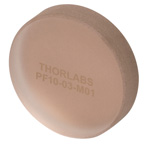
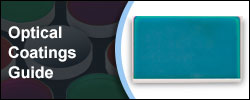
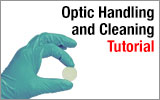
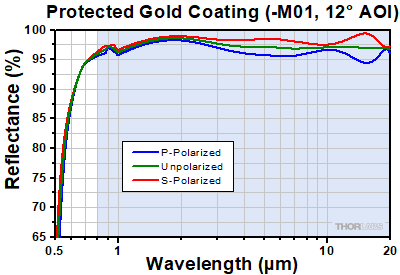
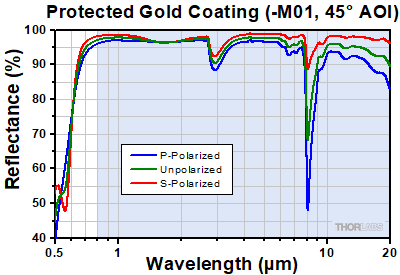

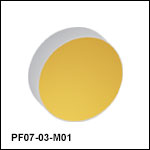
 ズーム
ズーム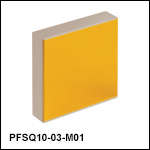
 金ミラー
金ミラー